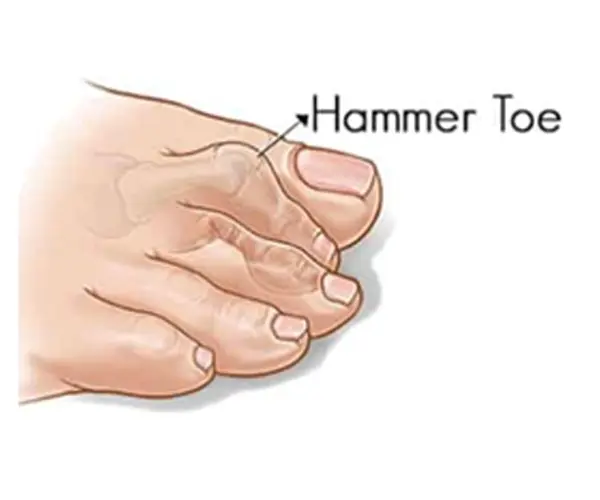Hammertoe Repair Specialist
What’s a Hammer Toe?
A hammer toe is a common foot deformity characterized by an abnormal bending of the toe joint. Typically affecting the second, third, or fourth toe, it can result from a combination of genetic predisposition, ill-fitting footwear, and muscle or tendon imbalances. The name “hammer toe” is derived from the toe’s resemblance to a hammer’s head, as it bends downward at the middle joint and then curls up at the end, creating a hammer-like shape.

The condition can cause discomfort, pain, and difficulty walking, especially when left untreated. In some cases, corns and calluses may develop on the affected toe due to friction and pressure against shoes. Early intervention, which may include wearing properly fitted footwear, using orthotic devices, and physical therapy, can help manage the symptoms and prevent the condition from worsening. In severe cases, surgery might be necessary to correct the deformity and alleviate pain. If you suspect you have a hammer toe, consult a healthcare professional for an accurate diagnosis and appropriate treatment options.
What Causes a Hammer Toe?
Hammer toes are a common foot condition characterized by the abnormal bending of one or more toe joints. Several factors contribute to the development of hammer toes, including:
Understanding these causes can help individuals take preventive measures, such as wearing comfortable, well-fitted shoes and addressing muscle imbalances through exercises and physical therapy, to reduce the risk of developing hammer toes.
Hammer Toe Symptoms
Hammer toe symptoms are easy to spot. It’s when your toe bends and looks like a little hammer. This can make your toe hurt, especially when you wear tight shoes. Sometimes, you might get bumps or rough spots on your toe, called corns or calluses. Finding comfy shoes can be hard, and your toe might not move as well. Sometimes, your toe might also swell or look red. If you see these things happening to your toe, it’s important to see a doctor. They can help make your toe feel better and prevent it from getting worse.
How is a Hammer Toe Diagnosed?
Diagnosing a hammer toe typically involves a physical examination by a healthcare provider. During the examination, the doctor assesses the toe’s appearance and range of motion. They may also inquire about symptoms and medical history. In some cases, X-rays can help assess the severity of the condition or rule out other foot problems. Based on the examination findings, the healthcare provider can make a proper diagnosis and recommend suitable treatment options to address the hammer toe.
Non-invasive Hammer Toe Treatment Options
Hammer toes, characterized by an abnormal bending of the toe joints, can be a source of discomfort and pain. Fortunately, there are several non-invasive treatment options available to help manage this condition and improve the quality of life for those affected.

These non-invasive treatment options are effective for managing hammer toes, especially when the condition is diagnosed early. However, it’s essential to consult a healthcare professional or a podiatrist before beginning any treatment regimen. They can provide personalized advice, recommend the most suitable options, and monitor your progress to ensure the best outcomes. In some cases, a combination of these treatments may be the most effective approach to relieve pain and prevent the condition from worsening.
Surgical Treatment Options for a Hammer Toe
When conservative treatments fail to alleviate the discomfort and pain associated with a hammer toe, surgical intervention may become necessary. Several surgical approaches aim to correct the deformity and provide lasting relief.
It’s crucial to note that surgical treatments for hammer toes come with potential risks and downtime. Patients should consult with a qualified podiatric surgeon to determine the most appropriate surgical approach for their specific condition. The choice of procedure will depend on factors such as the severity of the deformity, the patient’s overall health, and their preferences for long-term outcomes.
Following surgery, physical therapy and post-operative care are essential for a successful recovery. These treatments help restore functionality and reduce the risk of complications. By carefully considering the available surgical options and working closely with a healthcare professional, individuals can make informed decisions about their hammer toe treatment, ultimately improving their foot health and quality of life.
Benefits of Hammertoe Surgery
Hammertoe surgery offers significant benefits for individuals struggling with this painful condition. By correcting the toe’s misalignment and deformity, surgery can alleviate discomfort, improve foot function, and enhance overall quality of life. This procedure allows patients to regain the ability to wear a wider range of footwear, reducing the limitations imposed by the condition. Furthermore, addressing hammertoes surgically can prevent the development of complications, such as chronic pain, corns, and calluses, ultimately promoting better foot health and mobility, making daily activities more comfortable and enjoyable.
Hammer Toe Surgery Recovery
Recovery after hammer toe surgery typically involves a brief period of rest and foot elevation. Patients may wear a special shoe or cast to protect the operated toe. Full recovery can take a few weeks, depending on the specific procedure. Physical therapy may be recommended to regain strength and mobility.
Why Choose Apex Foot & Ankle Institute
for Hammer Toe Treatment?
Choosing Apex Foot & Ankle Institute for hammer toe treatment ensures expert care and exceptional outcomes. Our experienced team of podiatrists specializes in diagnosing and treating various foot conditions, including hammer toes, using the latest techniques and technologies. We offer personalized treatment plans, from conservative options to surgical interventions, ensuring patients receive the most suitable care. Our commitment to patient well-being, coupled with a history of successful outcomes, makes us a trusted choice for those seeking relief from hammer toe discomfort.

